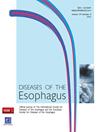328. 内镜下粘膜下剥离治疗浅表性食管癌累及整个食道:近期结果
IF 2.3
3区 医学
Q3 GASTROENTEROLOGY & HEPATOLOGY
引用次数: 0
摘要
由于术前难以准确诊断和内镜下粘膜剥离(ESD)技术的复杂性,累及整个食管的浅表性食管癌的治疗仍然具有挑战性。ESD术后食管狭窄的处理也存在争议。本研究结合近期疗效,分析我院浅表全周性食管癌ESD的优缺点。我们回顾性分析了10例自2021年1月至今诊断为累及整个周长的浅表性食管癌并接受ESD治疗的患者。我们评估了术前诊断的准确性、ESD的治疗相关并发症、ESD后狭窄以及与狭窄预防相关的不良事件。疗程:主要治疗方法为全麻环切,术后局部注射类固醇120 ~ 320 mg。患者在术后2-3天开始饮食,并开始口服类固醇治疗,起始剂量为30mg, PPI和磺胺甲恶唑甲氧苄啶。类固醇的剂量逐渐减少,每3周减少5mg,共18周。研究对象为男性7人,女性3人,平均年龄72.9岁。病变位于Upper 1, Middle 5和Lower 4。平均清扫时间89.1分钟,内镜下纵向粘膜缺损平均长度70 mm,整体切除率100%。组织学深度EP/LPM 5, MM/SM 13, SM2或更深2。术前诊断的准确率为80%,但所有SM2病变都被误诊为SM1。所有病例均未观察到与静电相关的不良事件。2例ESD后SM2患者接受了额外的手术。25%的病例发生狭窄。类固醇相关事件包括药物性肝功能障碍4例,食道念珠菌2例,肺结核1例,迟发性穿孔1例。累及整个食管的浅表性食管癌可安全有效地行ESD。类固醇可能有助于预防esd后狭窄,但其管理需要注意,因为它可能导致不良事件。本文章由计算机程序翻译,如有差异,请以英文原文为准。
328. ENDOSCOPIC SUBMUCOSAL DISSECTION FOR SUPERFICIAL ESOPHAGEAL CARCINOMA INVOLVING THE ENTIRE ESOPHAGUS: SHORT-TERM RESULTS
The treatment of superficial esophageal carcinoma involving the entire esophagus remains challenging due to the difficulty in accurate preoperative diagnosis and the complexity of the Endoscopic Submucosal Dissection (ESD) technique. The management of esophageal stricture following ESD also remains controversial. In this study, we analyzed the advantages and disadvantages of ESD for superficial whole circumferential esophageal carcinoma in our hospital, based on short-term results.
We retrospectively analyzed 10 patients diagnosed with superficial esophageal carcinoma involving the entire circumference and treated with ESD from January 2021 to the present. We evaluated the accuracy of preoperative diagnosis, treatment-related complications of ESD, post-ESD stenosis, and adverse events associated with stenosis prophylaxis.
Treatment Course: The primary treatment consisted of circumferential resection under general anesthesia followed by local injection of 120–320 mg of steroids into the ulcer after resection. Patients were started on a diet 2–3 days after surgery and initiated oral steroid therapy starting with 30 mg with PPI and Sulfamethoxazole Trimethoprim. The dose of steroids was gradually reduced by 5 mg every 3 weeks for a total of 18 weeks.
The study included 7 males and 3 females with a mean age of 72.9 years. The lesions were located in Upper 1, Middle 5, and Lower 4. The average dissection time was 89.1 minutes, the mean length of endoscopic longitudinal mucosal defects was 70 mm, and the en bloc resection rate was 100%. The histological depth was EP/LPM 5, MM/SM 13, and SM2 or deeper 2. The accuracy of preoperative diagnosis was 80%, but all SM2 lesions were underdiagnosed as SM1. No ESD-related adverse events were observed in any case. Two patients with SM2 after ESD underwent additional surgery. Stenosis occurred in 25% of cases. Steroid-related events included drug-induced liver dysfunction in 4 cases, esophageal candida in 2 cases, pulmonary tuberculosis in 1 case, and delayed perforation in 1 case.
ESD for superficial esophageal carcinoma involving the entire esophagus can be safely and effectively performed. Steroid administration may be useful for preventing post-ESD stenosis, but its management requires attention as it may cause adverse events.
求助全文
通过发布文献求助,成功后即可免费获取论文全文。
去求助
来源期刊

Diseases of the Esophagus
医学-胃肠肝病学
CiteScore
5.30
自引率
7.70%
发文量
568
审稿时长
6 months
期刊介绍:
Diseases of the Esophagus covers all aspects of the esophagus - etiology, investigation and diagnosis, and both medical and surgical treatment.
 求助内容:
求助内容: 应助结果提醒方式:
应助结果提醒方式:


